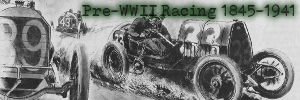















OLDFIELD LAUDS DE PALMA. |
|---|
 Topics: Ralph De Palma
Topics: Ralph De Palma
|
Barney Oldfield
The New York Times
June 1, 1915
Barney Also Pays a Tribute to the Three Placed American Cars.
Special to The New York Times.
(By Barney Oldfield.)
INDIANAPOLIS, May 31.—Ralph de Palma never faltered today. He defeated Dario Resta on truly won merit. Man and machine welded together in an effort that will live long in the memory of those who saw it at the Speedway, and for many years a race-loving public will be talking about the way the little Italian drove his German Mercedes over an American track, and for American dollars to a wonderful victory.
The new world's record—89.84 miles an hour—speaks for itself, and for the condition of men, machine, track, and weather. All combined in the great, sustained effort through 500 miles of strenuous going. Perhaps conditions will not soon again be such that so high a mark can be set.
De Palma's victory is directly attributable to two primary reasons, the man and the machine. Probably no other driver could have used the great German car to such advantage, and probably no other machine could have stood De Palma in such good stead. He has worked almost a full year in preparing for what today brought him, and he went into the race with a confidence possessed by none of his competitors.
The race was almost as much a victory for an American manufacturer, Harry Stutz, as it was for De Palma. Three Stutz cars started, and three finished in the money. Indeed, one of the trio ran a full 400 miles with but three cylinders shooting, yet "Howdy" Wilcox brought it through with an average of nearly eighty miles an hour.
And the other two Stutz, with Anderson at the wheel of the one that finished third and Cooper showing brilliant form at the wheel of the fourth to get the checkered flag, upheld the honors of America in great style. The cars were of a construction type new to Stutz. They showed up remarkably well in preliminary work, and when the test came they more than lived up to what was looked for by their maker and drivers.
Fifteen American cars, many of them patched up to resemble speed boats, were pitted against nine of Europe's best, so the result was not so disastrous to the home talent. At the finish there were eleven cars running, and six of these were Yankee made; indeed, it might be said that there were seven, for Burman's car has been almost entirely rebuilt in America.
Tom Hay had hardly dropped his starting flag before the advance indications as to where the race lay were being fulfilled. The three Stutz cars, De Palma, and Resta, were all that had really been figured, and right from the start they made the pace.
The first few laps found Anderson tooling his Stutz along far in the lead. In the second division were Cooper and Wilcox and Resta and De Palma, with Porporato of the Sunbeam and Rickenbacker in a Maxwell also showing a liking for choice company.
Anderson was forced into the pits for a tire change, the fast pace he was setting proving too much for his casings to stand. Then began a duel between De Palma and Resta which lasted until Ralph had disposed of his opponent in decisive fashion, but only when the race was almost at an end.
Leadership was a question of racing luck, for lap after lap, when one man was forced to the pits, the other went on about his business, only to find the score evened when he himself paid a visit for the helping hand brigade to exercise its talents.
Along about the 400-mile mark came the true finish of the race. De Palma stayed in the pits until Resta was a full lap ahead. The Peugeot appeared to have the better of the Mercedes when it came to a plain speed argument, but De Palma went after Resta just as though conditions were reversed.
De Palma figured that he had visited the pits for the last time, barring bad luck, and that Resta was due to stop at least once before the end of the race. With this in view Ralph pressed his advantage for all he was worth. He carried the battle to his man. In and out of the turns and down the stretches the Mercedes nagged and ragged the Peugeot without a second's rest. The campaign accomplished its purposes, for Resta finally went into his pits and when he came out again De Palma was left to go on his way unmolested. Had Resta gone after De Palma and battled to see which man or machine would "pop" first the verdict might have been reversed, for at the end the Peugeot appeared to be in better mechanical shape than the Mercedes.
Taken all in all, the race was clean cut all the way through, having about the average amount of trouble in store for all but the winner. The least that can be said for Resta is that he overcame many handicaps. The "breaks" were all against him, for time and again he was forced to fight his way through a scattering of slower cars that cut into his pace materially.
The pit work was both good and indifferent. Nothing wonderful developed in this regard, and in some instances it was deplorably slow.
